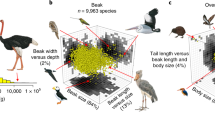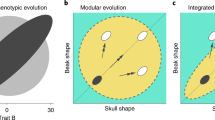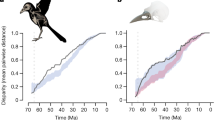Abstract
THE role of selective agents in the origin of evolutionary novelties has been controversial1–3 and has remained outside the realm of experiments. Here we experimentally determine both the benefits of a single trait and the advantages accrued during the presumed sequence of evolutionary steps leading to the fully specialized structure. By comparison of red crossbills (Loxia curvirostra, L.), in which the mandibular crossing has been removed, with controls and with the related but less specialized pine siskin (Carduelis pinus Wilson), we show the advantage of the mandibular crossing in the extraction of seeds from partially closed conifer cones. We use the natural regrowth of the mandibles to mimic the evolution of mandibular crossing from an unspecialized ancestor, and use the relationship of foraging efficiency to mandibular regrowth to determine a scheme for its (gradual) evolution.
This is a preview of subscription content, access via your institution
Access options
Subscribe to this journal
Receive 51 print issues and online access
$199.00 per year
only $3.90 per issue
Buy this article
- Purchase on Springer Link
- Instant access to full article PDF
Prices may be subject to local taxes which are calculated during checkout
Similar content being viewed by others
References
Frazzetta, T. H. Complex Adaptations in Evolving Populations (Sinauer Associates, Sunderland, MA, 1975).
Futuyma, D. J. Evolutionary Biology, 2nd edn (Sinauer Associates, Sunderland, MA, 1986).
Arnold, S. J. et al. in Complex Organismal Functions: Integration and Evolution in Vertebrates 403–433 (Wiley, New York, 1989).
Griscom, L. Proc. Boston Soc. nat. Hist. 41, 77–210 (1937).
Newton, I. Finches (Collins, 1972).
Tordoff, H. B. Condor 56, 346–358 (1954).
Benkman, C. W. Wilson Bull. 99, 351–368 (1987).
Benkman, C. W. Ibis 130, 288–293 (1988).
Arnold, S. J. Am. Zool. 23, 347–361 (1983).
Emerson, S. B. & Arnold, S. J. in Complex Organismal Functions: Integration and Evolution in Vertebrates, 295–314 (Wiley, New York, 1989).
Bock, W. J. & Wahlert, G. v. Evolution 19, 269–299 (1965).
Stephens, D. W. & Krebs, J. R. Foraging Theory (Princeton University Press, 1986).
Benkman, C. W. Ecol. Monogr. 57, 251–267 (1987).
Benkman, C. W. Ornis Scandinavica 20, 65–68 (1989).
Benkman, C. W. Auk 107, 376–386 (1990).
Gabrielson, I. N. & Lincoln, F. C. Birds of Alaska (Stackpole, Harrisburg, PA, 1959).
Austin, O. L. U. S. nat. Mus. Bull. 237, 424–447 (1968).
Martin, A. C., Zim, H. S. & Nelson, A. L. American Wildlife and Plants (Dover, New York, 1951).
Walsberg, G. E. Avian Biology, Vol. 7 161–220 (Academic Press, New York, 1983).
Raikow, R. J. Bull. Carnegie Mus. nat. Hist. 7, 1–43 (1978).
Martin, J. A. & Johnson, N. K. Condor 88, 409–420 (1986).
Tallman, D. A. & Zusi, R. L. Auk 101, 155–158 (1984).
Benkman, C. W. Evolution 43, 1324–1330 (1989).
Author information
Authors and Affiliations
Rights and permissions
About this article
Cite this article
Benkman, C., Lindholm, A. The advantages and evolution of a morphological novelty. Nature 349, 519–520 (1991). https://doi.org/10.1038/349519a0
Received:
Accepted:
Issue Date:
DOI: https://doi.org/10.1038/349519a0
This article is cited by
-
Strong evidence supporting a relationship between colour pattern and apparent survival in common crossbills
Journal of Ornithology (2022)
-
Molecular and cellular mechanisms underlying the evolution of form and function in the amniote jaw
EvoDevo (2019)
-
Crossed beaks in a local Swiss chicken breed
BMC Veterinary Research (2018)
-
Hook innovation boosts foraging efficiency in tool-using crows
Nature Ecology & Evolution (2018)
-
Drosophila pachea asymmetric lobes are part of a grasping device and stabilize one-sided mating
BMC Evolutionary Biology (2016)
Comments
By submitting a comment you agree to abide by our Terms and Community Guidelines. If you find something abusive or that does not comply with our terms or guidelines please flag it as inappropriate.



